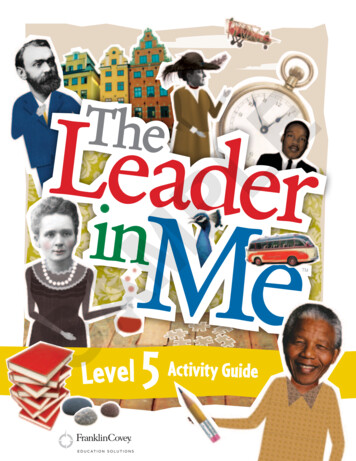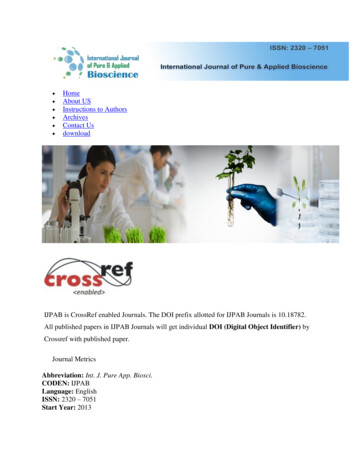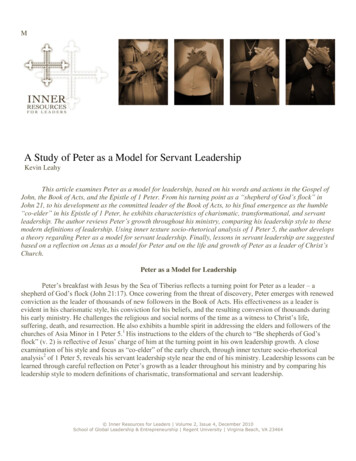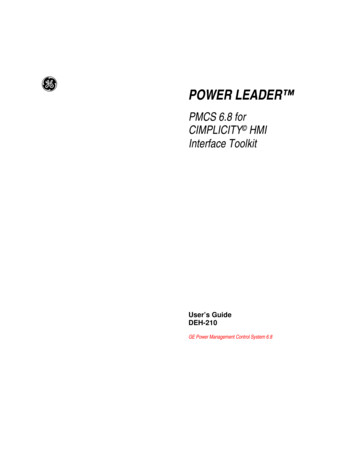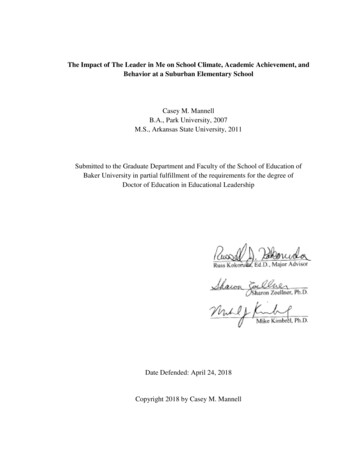
Transcription
The Impact of The Leader in Me on School Climate, Academic Achievement, andBehavior at a Suburban Elementary SchoolCasey M. MannellB.A., Park University, 2007M.S., Arkansas State University, 2011Submitted to the Graduate Department and Faculty of the School of Education ofBaker University in partial fulfillment of the requirements for the degree ofDoctor of Education in Educational LeadershipDate Defended: April 24, 2018Copyright 2018 by Casey M. Mannell
AbstractThe purpose of this study was to determine if there was a difference in thechanges in students’ and teachers’ perceptions of school climate, student achievement onRenaissance Learning’s STAR assessments, and student reactive recovery room visitsbetween Elementary School A and Elementary School B from before implementation ofTLIM at Elementary School A to three years after implementation of TLIM atElementary School A. The study focused on two elementary schools within SchoolDistrict X with similar enrollment and demographics. Students’ data were included in thestudy if the student attended Elementary School A or Elementary School B, was in thirdthrough fifth grade during the 2013-2014 school year or the 2016-2017 school year,completed the Student Advanced Questionnaire (AQ) survey, STAR Reading assessment,or STAR Math assessment. Teachers’ data were included in the study if they taught atElementary School A or Elementary School B and completed the Faculty AdvancedQuestionnaire (AQ) survey during the 2013-2014 school year or the 2016-2017 schoolyear.Findings of this study did not provide conclusive evidence that demonstratedTLIM had a positive effect on students’ and teachers’ perceptions of school climate,students’ academic achievement, and students’ behavior. The only measured positiveeffect to Elementary School A was the decrease in student reactive recovery room visitsbetween Elementary School A and an increase at Elementary School B, which was notstatistically significant. Other results in this study revealed decreases in the means forElementary School A on the student and faculty AQ surveys as well as students’achievement on STAR Reading and STAR Math assessments. The only statisticallyii
significant difference in change between the two schools was the decrease in thestudents’ perceptions of school climate at Elementary School A, which was significantlygreater than the decrease at Elementary School B.iii
DedicationTo my wife, whose endless love and support has guided me to accomplish morethan I ever dreamed possible.iv
AcknowledgementsIt was only through the support of the people around me that I was able tocomplete this amazing journey.To Dr. Russell Kokoruda, thank you for your support and guidance through thisentire process. You provided me with everything I needed when it was needed. Yourprobing questions in the beginning led me to a study with which I was passionate. Youprovided feedback that was straightforward and delivered with compassion. And whenthe end was near, you helped keep me focused on achieving my goal.To Dr. Peg Waterman, thank you for applying your expertise to my study. Iappreciate that you made me a priority. Without that, I never would have finished the lasttwo chapters in the time frame in which they were completed.To Dr. Sharon Zoellner and Dr. Mike Kimbrel, thank you for joining mydissertation committee. The knowledge and experience you added to the committeeresulted in the feedback and questioning required for me to finalize this dissertation.To my in-laws, Howard and Sheryl Matteson, I appreciate the many times youstepped in to fill the void I left with Krystina and the kids during those many eveningsand weekends when I was studying or writing. You likely helped in more ways than Ieven know, so thank you.To my friend Shelley Black, I appreciate the extra emotional and professionalsupport at work you provided during the many stressful moments while I have been inschool. And although I have been blessed with some very great friends in my life, theremay not be another who would be willing to read through this dissertation as many timesas you did.v
To Krystina, you are the most amazing wife and best friend. We have beenpartners in crime since we were teenagers. Even in the early stages of our relationship,you saw something in me that I was unable to recognize in myself. Over our many yearstogether, your unwavering love and support has not only resulted in me achieving morethan I dreamed possible, but we also built an amazing life together with two amazingchildren. I will always be grateful for the extra emotional support, householdresponsibilities, and parenting challenges you took on so I could pursue this dream. Younever cease to amaze me.To Ryland, without realizing it, you helped with my studies simply because youhave always been such a morning person. I will always treasure those countlessmornings where you snuck in and woke me up to watch cartoons before our ladies wereawake. I studied or wrote my dissertation while you watched cartoons, and for somereason you often crawled your way onto my shoulders to watch those cartoons while Iwas working on the laptop. With these moments, you helped keep our relationshipstrong.To Madyson, for most of my doctoral work, you were too young to realize howmuch I missed. However, I will always regret the moments I missed while you were ababy. I cherished your ability to lure me away from my studies with a simple “Daddy”followed by a request for a turn typing, a tea party, or just to snuggle. You helped meremember there was more to life than studying. Now that I am done, I am excited tomake up for those lost moments.To Grandpa, you passed away during my doctoral studies. Words cannot expressmy appreciation for the role you played in my life. Although I am happy you werevi
around to know the path I was on, I still wish you were here to see that I finished. Yourlessons about work ethic and humility continue to guide me through life.vii
Table of ContentsAbstract . iiDedication . ivAcknowledgements .vTable of Contents . viiiList of Tables . xiChapter 1 Introduction .1Background .2Statement of the Problem .5Purpose of the Study .6Significance of the Study .6Delimitations .7Assumptions.7Research Questions .8Definition of Terms.9Organization of the Study .10Chapter 2: Review of the Literature.11Contemporary School Reform .11Character Education .12Historical Context .13Defining Character .15Related Theories .16Character Education Objectives .18viii
Positive Effects .19The Leader in Me .21Historical Context .21Defining Leadership Principles.23Implementation Elements .24Current TLIM Research .25Perceptions .26Measurable Impacts .33Summary .40Chapter 3: Methods .41Research Design.41Selection of Participants .42Measurement .43Advanced Questionnaire (AQ) Surveys.43Standardized Testing and Reporting (STAR) Assessments.46Reactive Recovery Room Visits .49Data Collection Procedures.50Data Analysis and Hypothesis Testing .53Limitations .56Summary .57Chapter 4: Results .58Descriptive Statistics .58Hypothesis Testing.59ix
Summary .67Chapter 5: Interpretation and Recommendations .68Study Summary.68Overview of the Problem .68Purpose Statement and Research Questions .69Review of the Methodology.69Major Findings .70Findings Related to the Literature.71Conclusions .74Implications for Action .76Recommendations for Future Research .77Concluding Remarks .78References .79Appendices .88Appendix A. Student AQ Survey Items Used .89Appendix B. Faculty AQ Survey Items Used .95Appendix C. IRB Request Form .104Appendix D. IRB Approval Form .109x
List of TablesTable 1. 2013-2014 and 2016-2017 Elementary School Demographics .3Table 2. Principals’ Responses to Having Quantitative Data to Support Perceptions.29Table 3. Number of Participants for Hypothesis Testing .59Table 4. Descriptive Statistics for the Results of the Test for H1.61Table 5. Descriptive Statistics for the Results of the Test for H2.62Table 6. Descriptive Statistics for the Results of the Test for H3.63Table 7. Descriptive Statistics for the Results of the Test for H4.65Table 8. School A Student Reactive Recovery Room Status for H5 .66Table 9. School B Student Reactive Recovery Room Status for H5 .66xi
1Chapter 1IntroductionCurriculum is a term commonly used to describe district documents designed toguide classroom instruction toward student mastery of content that is specified by stateacademic standards. Marzano (2003) classified academic curricula into three categories,which include intended or written curriculum, implemented or taught curriculum, andattained or learned curriculum. However, curriculum exists in contexts beyond explicitacademic instruction. Such curriculum is referred to as the unwritten, or hidden,curriculum. Philip Jackson’s (1968) description of hidden curriculum includedexpectations of student behavior such as learning to wait quietly, exercising restraint,trying, completing work, keeping busy, cooperating, showing loyalty to teachers andpeers, being neat and punctual, and being courteous. Hlebowitsh (1994) described thehidden curriculum as part of the curriculum design and implementation considerations.Kentli (2009) described hidden curriculum as values, dispositions, and social andbehavioral expectations in a school. Kentli (2009) also explained that organizations andcompanies have collaborated with education researchers to develop integrated schoolculture reform programs and processes, which has resulted in a formerly hiddencurriculum becoming a visible, official one. The Leader in Me (TLIM) programexemplifies what Kentli (2009) described.The objective of TLIM is not to develop each child into a business leader butinstead to develop children into the leaders of their own lives (Covey, 2008b). TLIM isrooted in principles first described by Stephen Covey (2008b) in The 7 Habits of HighlyEffective People, which was adapted for younger audiences in 1998 with the publication
2of Sean Covey’s book The 7 Habits of Highly Effective Teens and again in 2008 by SeanCovey in The 7 Habits of Happy Kids (Covey, 2008a). Application of Covey’s 7 Habitsin schools emphasizes the use of common language, explicit leadership lessons,integrated leadership lessons, staff professional development, and staff modeling. SinceFranklinCovey Education formally began collaborating with schools to implement TLIMin 2009, TLIM has been adopted by over 3,000 schools in 50 countries (FranklinCoveyEducation, 2017b).BackgroundThis study was conducted in School District X, a moderate-sized suburban schooldistrict in the Kansas City, Missouri metropolitan area. At the time of the study, thedistrict included an early childhood education center, ten elementary schools, threemiddle schools, two high schools, and an alternative school. School District X’s K-12enrollment during the 2016-2017 school year was 11,287 students (School District X,2017). The student population in the 2016-2017 school year was comprised of 69.5%white, 11.7% African American, 9.3% Hispanic, 4.5% Multi-Racial, 3.2% Asian, 1.4%Pacific Islander, and 0.4% Native American students. School District X (2017) alsoreported that 27.9% of students qualified for the free or reduced lunch program.The study focused on two elementary schools within School District X withsimilar enrollment and demographics. Elementary School A implemented TLIM andElementary School B did not. Table 1 includes demographic data for the two elementaryschools from the years during which the study was conducted.
3Table 12013-2014 and 2016-2017 Elementary School hool ASchool BSchool ASchool BTotal Enrollment441437477518Multi-Racial22173125Pacific Islander1071215Native American4350Asian217617Hispanic57494652African ed3SES StatusFree/Reduced216172171194Full ity RateNote. Adapted from aElementary School B Principal, personal communication,September 25, 2017. bElementary School A English Language Learner Teacher, personalcommunication, September 26, 2017. c2016-2017 AQ faculty survey, by School DistrictX, 2017. dElementary school handbook: 2014-2015, by School District X, 2014a.eEnrollment summary: Scheduling/reporting ethnicity as of 05/19/2014, by SchoolDistrict X, 2014c. fMissouri comprehensive data system: School report card, by MissouriDepartment of Elementary and Secondary Education, 2017b.
4The principal of Elementary School A had first learned about TLIM through aMissouri Association of Elementary School Principals (MAESP) professionaldevelopment conference in St. Louis, Missouri in 2010 (Elementary School A Principal,personal communication, January 12, 2017). She attended leadership days at St. LouisLeader in Me schools, which are formal presentation days during which schoolsdemonstrate TLIM’s impact for outside guests. Although impressed with what she saw,Elementary School A’s principal found it difficult to visualize day-to-day implementationand effectiveness at Elementary School A because the demographics at the schools shevisited contrasted with the demographics at her elementary school.Elementary School A’s principal described two parallel paths she considered forthe next two years following her attendance at the MAESP professional developmentconference (Elementary School A Principal, personal communication, January 12, 2017).The school’s character education program at that time did not create a school culture inwhich students displayed the desired character traits or made adequate academicprogress. Elementary School A’s principal questioned whether students were effectivelylearning skills they could utilize in their daily lives. One path the principal consideredinvolved altering implementation of the character education program they were using.The second path she considered was abandoning the character education program forsomething entirely different and more comprehensive.While Elementary School A’s principal was considering those two paths,Elementary School C, a third elementary school in School District X, implemented TLIMduring the 2012-2013 school year. This provided Elementary School A’s principal with amore comprehensive view of TLIM (Elementary School A Principal, personal
5communication, January 12, 2017). She was able to investigate its application on a dayto-day basis, rather than through the formal leadership day. She also engaged in dialoguewith the principal of the implementing school and gained insight into how closely alignedTLIM’s emphasis on continuous improvement mirrored the beliefs and directives ofSchool District X. That new insight was enough for Elementary School A’s principal toselect TLIM for implementation at her school.Statement of the ProblemElementary School A’s proficiency on the state assessment combined with theschool’s student discipline data in the years preceding this research had reflected a schoolin need of reform. In 2008 Elementary School A had made adequate yearly progress(AYP) on the state’s communication arts and mathematics assessments (MissouriDepartment of Elementary and Secondary Education, 2017a). However, the school failedto make AYP in communication arts in 2009, 2010, and 2011. Although the school madeAYP in mathematics in 2009, the school failed to make AYP in 2010 and 2011. Thisdata demonstrating the school’s inability to make AYP on the state assessment supportedthe principal’s intuition that change was necessary. In addition to declining standardizedassessment scores, there were a high number of student reactive recovery room visits atElementary School A. Reactive recovery room visits were instances where students weresent to the recovery room as a result of behavior that interfered with the academic settingor learning environment (School District X, 2014b). The school began storing thisdiscipline data in Matrix, School District X’s data storage system, during the 2011-2012school year (School District X, 2018). During that year, there were 1,021 reactiverecovery room visits at Elementary School A.
6Elementary School A’s data indicated the need for comprehensive reform. Ifindeed TLIM was a comprehensive school reform model (CSR), then it would impactschool climate, academic achievement, and student behavior. Both students and teacherswould be able to identify the program’s impact, and it would validate implementation ofTLIM. Determining the impact of TLIM on Elementary School A required furtherinvestigation.Purpose of the StudyThe first purpose of this study was to determine if there was a difference in thechange in students’ and teachers’ perceptions of school climate between ElementarySchool A and Elementary School B from before implementation of TLIM at ElementarySchool A to three years after implementation of TLIM at Elementary School A. Thesecond purpose of this study was to determine if there was a difference in the change instudent achievement on Renaissance Learning’s STAR assessments between ElementarySchool A and Elementary School B from before implementation of TLIM to three yearsafter implementation of TLIM at Elementary School A. The third purpose of this studywas to determine if there was a difference in the change in student reactive recoveryroom visits between Elementary School A and Elementary School B from beforeimplementation of TLIM at Elementary School A to three years after implementation ofTLIM at Elementary School A.Significance of the StudyThis study could extend the literature on TLIM’s impact on schools and provideevidence of TLIM’s effectiveness or ineffectiveness for school leaders and districtleaders. Evidence could clarify how school climate, students’ academic achievement,
7and students’ behavior were affected by implementation of TLIM. Results from thisstudy will contribute to the existing body of research and could be a factor in determiningwhether TLIM is worth the investment.DelimitationsLunenburg and Irby (2008) described delimitations as “self-imposed boundariesset by the researcher on the purpose and scope of the study” (p. 134). The followingdelimitations in this study were used to narrow the scope of the study. Archival data, including teacher and student climate survey data and studentperformance on the STAR assessment, were used from Elementary School Aand Elementary School B; Student academic and climate data for this study were limited to that whichwas collected in third through fifth grade because students attending thosegrades completed the academic assessments and surveys on school climate; Renaissance Learning’s Standardized Testing and Reporting (STAR) readingand mathematics assessments were selected as the academic measure due toconsistency of those assessments; Behavior data only included students’ reactive recovery room visits becausethis accounts for more behaviors than those that are severe enough to warrantoffice discipline referrals.AssumptionsLunenburg and Irby (2008) described assumptions as “postulates, premises, andpropositions that are accepted as operational for purposes of the research” (p. 135). Thefollowing assumptions were made regarding the study:
8 TLIM elements were implemented with fidelity. The schools reported data honestly and accurately. Students and staff answered survey questions honestly. Staff followed district policies and procedures pertaining to student disciplineprior to sending a student to the recovery room.Research QuestionsThe following research questions were used to guide the study:RQ1. To what extent is there a difference in the change in students’ perceptionsof school climate between Elementary School A and Elementary School B from beforeimplementation of TLIM at Elementary School A to three years after implementation ofTLIM at Elementary School A?RQ2. To what extent is there a difference in the change in teachers’ perceptionsof school climate between Elementary School A and Elementary School B from beforeimplementation of TLIM at Elementary School A to three years after implementation ofTLIM at Elementary School A?RQ3. To what extent is there a difference in the change in student achievement onRenaissance Learning’s STAR assessments between Elementary School A andElementary School B from before implementation of TLIM at Elementary School A tothree years after implementation of TLIM at Elementary School A?RQ4. To what extent is there a difference in the change in student reactiverecovery room visits between Elementary School A and Elementary School B frombefore implementation of TLIM at Elementary School A to three years afterimplementation of TLIM at Elementary School A?
9Definition of TermsThis section includes definitions of key terms used in this study. Knowing howthese terms are defined will help the reader better understand the study.Cohort Effect. Alwin and McCammon (2003) described cohort effect as theimpact that such characteristics as common life experiences, size, cohesiveness, andcompetition can have on a bonded group of people.Lexile. According to Renaissance Learning (2014), Lexile is a reading levelmeasurement scale ranging from BR400L to 1825L. The “BR” indicates a score belowzero that typically indicates beginning readers.Mobility Rate. According to School District X (2014a), mobility rate is thepercentage of students who were new to the district in a given year.Recovery Room. The recovery room is described as “a safe place for students tothink and problem-solve when they are unable to manage their behavior” (School DistrictX, 2014b, p. 35).Scaled Scores (SS). Renaissance Learning (2014) defined scaled score as a scaledeveloped by using Item Response Theory (IRT) for adaptive assessment item selectionand scoring. Scaled scores are expressed on a common scale across all grade levels, thusbecoming comparable with each other regardless of grade level (Renaissance Learning,2015b).School Climate. According to National School Climate Council (2007), schoolclimate is defined as the quality and character of school life that reflects norms, goals,values, interpersonal relationships, teaching, learning and leadership practices, andorganizational structure.
10School Culture. Gruenert (2008) defined school culture as unwrittenexpectations, rules, or beliefs that have been developed within the school.Organization of the StudyThis study is presented in five chapters. The first chapter included an introductionto the study and TLIM as well as background about the school district and schoolsincluded in the study. Chapter 1 also included the statement of the problem, purposestatement, and significance of the study, in addition to listing the delimitations,assumptions, research questions, and definition of terms. Chapter 2 includes the reviewof existing literature. Context for this study is developed through a review of currentliterature. A description of the study’s methodology is in Chapter 3. In Chapter 4, thedata analysis results are presented. A summary of the study, review of literature,implications for action, recommendations for further study, and other conclusions areincluded in Chapter 5.
11Chapter 2Review of the LiteratureThe purpose of this study was to evaluate whether there is a difference in thechanges in school climate, students’ academic achievement, and students’ behaviorbetween an elementary school that has implemented TLIM and one that has notimplemented TLIM. This review of literature established the context for TLIM in theeducation system. The review of literature also focused on TLIM’s perceived andmeasured impacts.Contemporary School ReformContemporary school reform can be traced back to A Nation at Risk (Gardner et.al., 1983). That report began the systemic reform process by initiating recommendationsto increase the rigor of academic standards, to make the school day longer, to improveteacher preparedness, and to hold elected officials accountable to provide fiscal support.The No Child Left Behind Act (NCLB) facilitated further school reform in 2001 (U.S.Department of Education, 2001). Principles contained in NCLB included
of Sean Covey’s book The 7 Habits of Highly Effective Teens and again in 2008 by Sean Covey in The 7 Habits of Happy Kids (Covey, 2008a). Application of Covey’s 7 Habits in schools emphasizes the use of common language, explicit leadership lessons, integrated leadership lessons,

